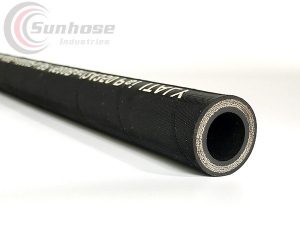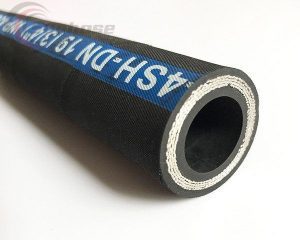What is the difference between 4sp and 4sh hose?
The choice of hydraulic hoses plays a crucial role in ensuring the smooth and efficient operation of hydraulic systems. Two commonly used hoses are the 4SP and 4SH hoses. While they may seem similar at first glance, there are notable differences between them that make each suitable for specific applications. In this article, we will explore the dissimilarities between 4SP and 4SH hoses, understand their unique characteristics, and determine when to use each type.
Hydraulic hoses are essential components used in hydraulic systems to transmit fluid power. They are designed to withstand high-pressure conditions and deliver fluids effectively. The 4SP and 4SH hoses are both high-pressure hoses commonly utilized in hydraulic applications. However, they differ in terms of construction, reinforcement, and overall performance.
According to the world production standards, which for most plants is the European standard EN856, there are four types of winding design hydraulic hoses: 4SP and 4SH.
Exploring 4SP Hoses
4SP hoses are multi-spiral hoses that offer excellent flexibility and high-pressure resistance. They are constructed with four layers of spiraled high-tensile steel wires, providing enhanced strength and durability. The reinforcement layers are evenly spaced, ensuring equal distribution of pressure throughout the hose.
4SP hoses are manufactured by winding four spirals into a power cord. They are used in conditions of medium pressures that range from 450 bar to 165 bar.

4SP Spiral rubber hose
Hydraulic Hose EN856 4SP
- Tube: high-quality synthetic rubber compounds.
- Reinforcement: four-spiral high tensile steel wires.
- Cover: abrasion and weather-resistant synthetic rubber.
- Temperature: -40 °C to +100 °C (-40 °F to +212 °F).
Analyzing 4SH Hoses
On the other hand, 4SH hoses are also multi-spiral hoses but feature a higher number of reinforcement layers. They are constructed with four to six layers of spiraled high-tensile steel wires, making them even more robust than 4SP hoses. The additional reinforcement enables 4SH hoses to withstand extremely high-pressure conditions.
The design of the 4SH hose is also a winding of four spirals, but the wire has a special strength reinforcement, which allows the use of the hose in high-pressure conditions.
4SH hoses are available in diameters that range from 20 mm to 50 mm with a working pressure range from 430 bar to 280 bar. This working pressure is an order of magnitude higher than the 4SP type.

High-Pressure 4SH hose
Hydraulic Hose EN856 4SH
- Tube: high-quality synthetic rubber compounds.
- Reinforcement: four-spiral high tensile steel wires.
- Cover: abrasion and weather-resistant synthetic rubber.
- Temperature: -40 °C to +100 °C (-40 °F to +212 °F).
Hoses designed with a winding construction are actively used in mining equipment and mining fields.
Key Differences Between 4SP and 4SH Hoses
The main differences between 4SP and 4SH hoses lie in their construction and pressure ratings. While both hoses can handle high-pressure applications, 4SH hoses have a higher pressure rating due to their additional reinforcement layers. The increased strength of 4SH hoses makes them suitable for extremely demanding hydraulic systems.
DIN EN856 4SP and 4SH can be used for forklifts, hydraulic engines, oilfield extraction machinery, mine/road/construction machinery, and so on.
Applications of 4SP Hoses
4SP hoses find applications in various industries and machinery where high-pressure hydraulic systems are involved. Some common applications include construction equipment, agricultural machinery, mining machinery, and industrial machinery. These hoses are well-suited for systems operating at moderate to high pressures.
Applications of 4SH Hoses
Due to their superior strength and ability to handle extreme pressure conditions, 4SH hoses are commonly used in heavy machinery and equipment. Industries such as mining, drilling, construction, and offshore operations rely on 4SH hoses to withstand the rigorous demands of their hydraulic systems.
Conclusion
In conclusion, the difference between 4SP and 4SH hoses lies in their construction, reinforcement, and pressure ratings. 4SP hoses offer excellent flexibility and high-pressure resistance, making them suitable for moderate to high-pressure hydraulic systems. On the other hand, 4SH hoses provide enhanced strength and can withstand extremely high-pressure conditions, making them ideal for heavy machinery and demanding applications.
FAQs
Q1. Can I use a 4SP hose in a high-pressure application?
Yes, 4SP hoses are designed to handle high-pressure conditions and can be used in various applications requiring moderate to high pressures.
Q2. Are 4SH hoses more expensive than 4SP hoses?
Generally, 4SH hoses tend to be slightly more expensive due to their additional reinforcement layers and higher pressure rating.
Q3. Can I use a 4SH hose instead of a 4SP hose if I need higher pressure resistance?
Yes, if your hydraulic system requires higher pressure resistance, opting for a 4SH hose is recommended due to its ability to withstand extreme pressure conditions.
Q4. Are 4SP and 4SH hoses interchangeable?
While both hoses serve similar purposes, it is advisable to use the hose specified by the manufacturer for your specific application to ensure optimal performance and safety.

 Sunhose
Sunhose sunhose
sunhose